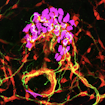
Daniel Balakov/iStock
On July 29, 2020, the Simons Foundation Autism Research Initiative (SFARI) convened an online workshop to explore environmental (maternal and fetal) risk factors for autism spectrum disorder (ASD) in the context of COVID-19 infection.
Pregnancy is a critical time for brain development, and a mother’s health during gestation may have long-lasting effects in her child. While genetics is a major contributor to autism risk, other factors may also play a role. Epidemiological studies1-3, as well as research using mouse models of maternal immune activation (MIA)4-6, have linked autism risk to gestational infection and inflammation; examinations of postmortem brain tissue have found signs of immune system activation in the brain of individuals with autism7-10.
The purpose of the workshop was to learn more about current research efforts about COVID-19, pregnancy and the risk for developmental conditions in babies born from mothers who contracted the virus during gestation.
To date, SFARI has funded various projects exploring the link between maternal infection and inflammation and autism, with many of these studies focusing on MIA mouse models and analyses of postmortem brains. The tragedy of the pandemic could now provide opportunities to better understand how maternal infection, inflammation and fever during pregnancy are related to autism risk at the population level. One goal of the workshop was therefore to learn how SFARI could contribute by helping leverage existing cohorts, establish processes to standardize collection of biospecimens, facilitate data sharing, or address unexpected or unmet needs.
“We wanted to take stock of the current landscape of human studies, in the United States and worldwide, in order to identify ways to facilitate this research or to stimulate synergy and collaborations,” says Marta Benedetti, SFARI senior scientist and co-host of the workshop.
“We were also interested in thinking about what is specifically needed to study autism risk in the context of COVID-19 infection,” added Paul Wang, Clinical Research Associates deputy director, who co-hosted the workshop with Benedetti.
Thirty-eight researchers and Simons Foundation scientists attended the workshop. Fourteen speakers gave brief talks, and many of them are stewards of ongoing longitudinal studies of mothers and their offspring. To understand the effects of the novel coronavirus, SARS-CoV-2, in this context requires sufficient time for follow-up, to see if children develop autism, and some nimbleness in taking advantage of the moment to get started.
What we know: Maternal fever, infection and ASD
Mady Hornig of Columbia University began with some clues about COVID-19 and pregnancy: pregnant women hospitalized with COVID-19 are often minorities; vertical transmission from mother to fetus has been documented though it is rare; and placental changes are apparent. Fever, a feature of both mild and severe COVID-19 infections, raises flags because maternal fever itself has been associated with increased risk for autism. This includes a study from Hornig and colleagues of over 100,000 mothers and their children from the Norwegian Mother and Child Cohort Study (MoBa): fever during the second trimester of pregnancy was associated with increased risk for autism compared to pregnancies without fever (adjusted odds ratio, 1.40), with markedly increased risk with multiple fever episodes in later stages of pregnancy (adjusted odds ratio, 3.12)1. To begin to understand the biological mechanisms behind this, Hornig and colleagues are now analyzing levels of 60 different immune molecules in blood collected from pregnant mothers and from their children at birth to see if there are signals associated with autism.
A link has been drawn before between inflammation-related immune molecules during pregnancy and autism risk in the Early Markers for Autism Study (EMA). Lisa Croen of Kaiser Permanente described this population-based study of women from the Kaiser Permanente health system that collected mid-gestational maternal blood and neonatal blood spots for routine screening. Her collaborator Judy Van de Water of University California, Davis described the results, which revealed elevated levels of inflammatory chemokines and cytokines in mothers whose babies later developed a combination of autism and intellectual disability2. Croen also described an ongoing prospective study, called the Immune and Metabolic Markers during Pregnancy and Child Development (IMPaCT), which aims to explore these molecular profiles during pregnancy to see if they are associated with neurodevelopmental disorders and/or with maternal health factors, such as obesity or asthma (Table 1). Croen outlined a proposed study that would gather another cohort of 45,000 pregnant women from the Kaiser Permanente system. Using the IMPaCt cohort as a pre-pandemic control group, the study could identify the effects of maternal infection and pandemic-induced stress on biomarkers in maternal and neonatal blood as well as outcomes for babies born during the pandemic.
Infection on its own may not be sufficient to boost autism risk, at least not in a mouse model of maternal immune activation developed by Jun Huh of Harvard Medical School, as part of a project funded by SFARI. In Huh’s experiments, pregnant mice given Poly(I:C) injections to mimic viral infections produce male offspring with social deficits and repetitive behaviors reminiscent of autism features, as well as cortical changes, but only if a kind of bacteria was present in the mother’s gut4. From the gut, these bacteria promote development of Th17 cells, which produce interleukin-17, a pro-inflammatory cytokine that crosses the placental barrier to bind to a receptor in the fetal brain. This suggests that Th17 cells could represent therapeutic targets to mitigate the disruptive effects of maternal immune activation during pregnancy.

Current efforts related to COVID-19
Huh also gave a brief description of what is known so far about immune system responses to the SARS-CoV-2 virus. Similar to other RNA viruses that infect humans, the SARS-CoV-2 virus activates innate immune pathways and induces T cells that target parts of the virus. The virus also provokes some notable reactions: a subdued interferon response, which normally alerts other cells to a pathogen; a decrease in the number of T cells or their functionality; hyperactivation of cytokines (as in the “cytokine storms” associated with COVID-19); and a change in gut bacteria. To get at the narrower question of how the immune system of pregnant women responds to SARS-CoV-2, Huh is planning to collect biospecimens from pregnant women infected with the virus to understand how their immune system responds to the infection (Table 1).
Existing research infrastructure can be quickly marshaled to study the novel coronavirus’ effects on pregnancy, as Torri Metz of the University of Utah described for the Maternal-Fetal Medicine Units (MFMU) Network. The MFMU network consists of 12 sites in the United States, funded by the Eunice Kennedy Shriver National Institute of Child Health and Human Development (NICHD), that collaborate to perform clinical trials and observational studies of pregnant women. A new study, MFMU GRAVID (Gestational Research Assessments for coVID-19), has begun to look at morbidity and mortality in women giving birth during the pandemic and compare it to pre-pandemic data collected in 2019. The study will also look specifically at women who have been infected with the novel coronavirus while pregnant to understand the effects of the infection on their morbidity and mortality as well as immediate outcomes for their newborns. This study is currently enrolling at all MFMU sites (Table 1).
Drawing from her experience of studying Zika virus in pregnant women, Karin Nielsen of the University of California, Los Angeles outlined a new study called COMP (COVID Outcomes in Mother-Infant Pairs) that is investigating the effects of SARS-CoV-2 infection on 200 pregnant women from prenatal clinics in Brazil and the Los Angeles region. Begun in April, the COMP study builds upon infrastructure established for Zika studies, in which Nielsen and colleagues tracked a variety of outcomes in both mother and child, demonstrating brain imaging abnormalities and developmental delay in about one-third of children11. The COMP study will look at similar clinical and neurodevelopmental outcomes in mothers and children followed for 12 months after birth and will also track their immune responses, monitoring immunoglobins, chemokines, cytokines and T-cell responses (Table 1).
Thomas Werge of the University of Copenhagen described the expansive epidemiologic infrastructure in Denmark, which enables studies of its entire population. This allows them to “know what the denominator is” he said and gives very precise risk estimates for conditions like autism. Denmark has a civil registration system, in which each person receives a personal identity number, which can then be linked to their relatives and to records containing information about prescriptions, psychiatric services, medical birth and a biobank that stores neonatal blood spots of everyone born in Denmark since 1981. This infrastructure could be used to follow-up children born during the pandemic. COVID-19 related work is underway using subjects from the Danish Blood Donor Study, which enrolls about 5 percent of the population and for which subjects give a blood sample and answer questionnaires.
A more circumscribed program centered on women’s health called eLIXIR (early-LIfe data cross-LInkage in Research) was described by David Edwards of King’s College London. This study combines data from pregnant women and their newborns with information from their electronic health records accrued over time, including general health, psychiatric and pediatric records. This structure is now being used to get at the consequences of SARS-CoV-2 infection during pregnancy. Based in London, eLIXIR also collects blood samples from pregnant women and includes brain imaging of neonates, which can pick up abnormalities12. The study will also collect clinical and immunological data associated with SARS-CoV-2 infection. Enrollment is underway, with a goal of recruiting 100–200 women with COVID-19 infection during pregnancy (Table 1). Colleague Lucilla Poston noted that offering a SARS-CoV-2 test as part of prenatal care encouraged recruitment into eLIXIR, which may last longer than anticipated because the virus remains a health risk.
Peter von Dadelszen of King’s College London described the PRECISE (PREgnancy Care Integrating translational Science, Everywhere) Network, which investigates complications of pregnancy in three sites in Africa (The Gambia, Mozambique and Kenya), with a focus on maternal hypertension during pregnancy, fetal growth restriction and stillbirth. As part of this, researchers have created a biorepository of maternal biological samples, as well as cord blood and placenta. PRECISE will eventually include 6,000–10,000 women, and a related project, PRECISE-DYAD, will follow-up the mothers and offspring for at least two to three years (Table 1). These countries have been hit very hard with COVID-19, and so the project has begun to track SARS-CoV-2 infections in pregnant women. Their findings could provide unique perspectives on COVID-19 given that African women have very different comorbidities and greater genetic diversity than that found in the ‘global north,’ where research predominates.
In the United States, a prospective study on maternal health and outcomes focused on pregnancies ascertained in the first trimester (<10 weeks) launched in May. Called ASPIRE (for Assessing the Safety of Pregnancy In the coRona virus pandEmic) and led by Heather Huddleston of the University of California, San Francisco, the study will explore maternal and infant outcomes through at least 18 months of life in relation to SARS-CoV-2 infection. Infection status and timing of infection will be ascertained through antibody testing, using dried blood-spot specimens collected throughout pregnancy at 16 time points. ASPIRE aims to collect data from 10,000 women, and compare outcomes between those who were exposed and those who were not. As of November 2020, ASPIRE has enrolled 1,500 participants, with an estimated 2–5 percent positivity rate for SARS-CoV-2 (Table 1). Positivity rates are expected to rise throughout the winter months. Dried blood spots may be used to interrogate other markers, including inflammatory ones.
Wendy Chung of Columbia University and director of clinical research at SFARI then described SPARK (Simons Foundation Powering Autism Research for Knowledge) — a SFARI-supported initiative that collects medical and genetic data from children with autism and their families across the United States. SPARK comes with a free ‘research match’ program to link researchers to consenting SPARK participants for recruitment in research studies. In the context of maternal infection with SARS-CoV-2 and autism risk, Chung noted that many participating families are still in the child-bearing phase of life and so could provide a cohort of at-risk pregnancies. For example, a recent COVID-19 survey of SPARK participants brought in over 4,400 replies, and 3 percent of participating mothers are either pregnant or have had a baby within the past six months; some also report having had COVID-19.
Alice Kau, program director at the Eunice Kennedy Shriver National Institute of Child Health and Human Development (NICHD), said that they were interested in how SARS-CoV-2 infection impacted their population of interest, which includes pregnant and lactating mothers, children and people with intellectual, developmental or physical disabilities. She outlined three efforts for COVID-19 study: the MFMU Network, which is enrolling 21,000 women (see Torri Metz above); the Global Network for Women’s and Children’s Health Research, which will study pregnancies in resource-limited countries in partnership with the Gates Foundation; and an intramural program operating in Detroit. To study questions about SARS-Cov-2 infection, Kau pointed to a mechanism that allows administrative supplements to be made to ongoing National Institutes of Health (NIH) grants, including investigations of behavioral and social sciences (NOT-OD-20-097) and maternal mortality (NOT-OD-20-104).
The Center for Disease Control (CDC) also runs a study to understand factors that contribute to autism risk. Called the Study to Explore Early Development (SEED), the study collected a comprehensive set of measures on both pregnant women and their children, including genetic data, maternal immune factors and a number of assessments of child health and autism features. Karen Pazol of the CDC described SEED’s biorepository of saliva and blood samples from both mother and child.
Click here to view PDF of the table

Moving forward
The workshop concluded with a group discussion, moderated by Paul Wang. He began by asking the attendees to think about what was needed to understand the novel coronavirus’ impact on risk for autism. This could include gaps in scientific knowledge, but also operational and logistic gaps, such as things that affect ease of collaboration or data sharing.
The discussion touched on several questions, including how data collection is affected by social distancing and mask wearing. For example, making gold-standard autism diagnoses is complicated when the evaluator is wearing a mask or is only seen on a screen; specimen collection also becomes difficult with people staying at home. Some at-home saliva and blood sampling can be done, but researchers emphasized that data collection works best when it ‘piggybacks’ on top of routine clinical care, such as during prenatal visits, which continue during the pandemic. In planning these studies, another point that was made is that stool samples should not be overlooked, both because the microbiome has a strong effect on the immune system and because it can provide information about the body’s response to stress.
Another critical issue is that many of these mother-child studies do not follow the child long enough to know whether they actually develop autism. As autism is often not diagnosed until school age, SFARI is particularly interested in ensuring that children born during the pandemic are followed for a sufficient amount of time to assess autism risk. This highlighted the need to extend the follow-up period of the studies or to find ways to recontact participants; electronic health records could also provide this information on a large scale. The importance of achieving diversity in the population participating in these cohorts emerged at different moments during the discussion.
“This has been a very informative and collaborative meeting,” says John Spiro, SFARI interim director. “We look forward to continuing the discussion offline and to find ways in which SFARI can best support research on maternal infection and autism risk in light of the COVID-19 pandemic and beyond this international emergency.”
References
- Hornig M. et al. Mol. Psychiatry 23, 759-766 (2018) PubMed
- Jones K.L. et al. Mol. Psychiatry 22, 273-279 (2017) PubMed
- Lee B.K. et al. Brain Behav. Immun. 44, 100-105 (2015) PubMed
- Kim S. et al. Nature 549, 528-532 (2017) PubMed
- Yim Y.S. et al. Nature 549, 482-487 (2017) PubMed
- Choi G.B. et al. Science 351, 933-939 (2016) PubMed
- Vargas D.L. et al. Ann. Neurol. 57, 67-81 (2005) PubMed
- Gupta S. et al. Nat. Commun. 5, 5748 (2014) PubMed
- Morgan J.T. et al. Biol. Psychiatry 15, 368-376 (2010) PubMed
- DiStasio M.M. et al. Ann. Neurol. 86, 885-898 (2019) PubMed
- Nielsen-Saines K. et al. Nat. Med. 25, 1213-1217 (2019) PubMed
- O’Muircheartaigh J. et al. Brain 143, 467-479 (2020) PubMed


